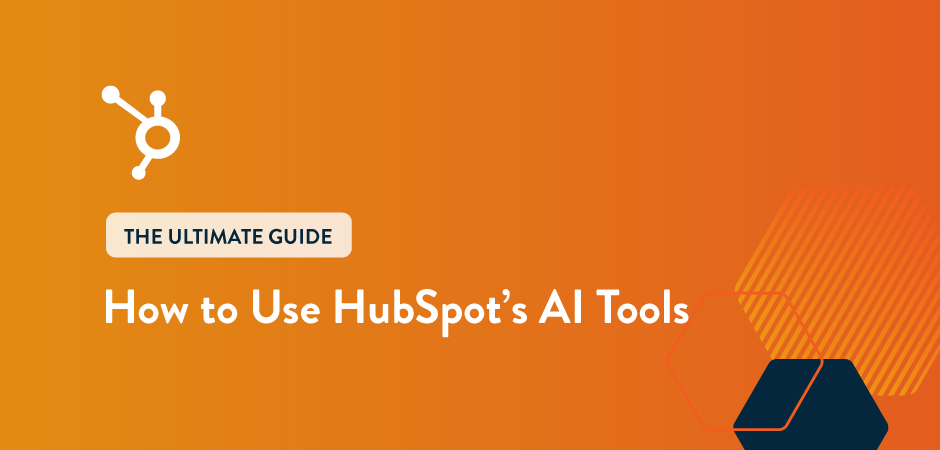
If your team uses HubSpot, you already know it’s a powerful CRM for marketing, sales, and service. What many teams are now realizing is that HubSpot’s built-in AI tools, called Breeze AI, can take that power further by automating content, surfacing insights, and freeing your team to do more strategic work. We’ll walk you through what these tools are, why they matter, and a step-by-step guide to how to use them in your HubSpot portal.
Why AI in HubSpot Matters
Before jumping into how, let’s set the stage for why.
- Because the pace of digital marketing, sales outreach, and customer service keeps accelerating, teams need to do more with limited resources. HubSpot’s AI tools help with that by automating repetitive tasks, generating draft content, screening leads, and analyzing data.
- These AI features are built directly into HubSpot’s CRM and hubs — meaning less context-switching, fewer external tools, and better alignment between marketing, sales and service.
- When set up well, you get faster content production (blogs, landing pages, emails), smarter lead scoring and CRM enrichment, plus improved efficiency in service workflows.
- HubSpot emphasizes trust, privacy, and context. Your data and your business voice remain central.
In short: if you’re using HubSpot and want to scale your operations without necessarily scaling headcount, leveraging these AI tools is a smart move.
What Are HubSpot’s AI Tools?
HubSpot’s AI functionality is packaged under the Breeze brand. The key components are:
- Breeze Copilot — an AI assistant that lives across the platform and helps you draft content, summarize records, prep for meetings, and more.
- Breeze Agents — specialized AI “workers” (or assistants) built for tasks like content generation, prospecting, support ticket automation, etc.
- Breeze Intelligence — the data‐driven part: enrichment, buyer-intent signals, predictive scoring, insights from your CRM data.
How Do I Get Started with Breeze AI? Setup & Best Practices
Here’s a step-by-step guide to implementing and using these AI tools inside HubSpot effectively.
1. Check Your Tier & Enable the Features
First, verify which HubSpot subscription you are on and what AI features are included. Some advanced Agents may require Professional or Enterprise editions.
In your HubSpot portal, go to Settings → AI or search for “AI” or “Breeze” within your settings.
Also, check Product Updates or your portal’s update center: some features may still be in beta and need to be opted into.
2. Configure Your Data & Brand Context
To get the most value, you’ll want to feed the AI your business context: brand voice guidelines, audience profiles, CRM data, content history. This helps ensure the AI’s output aligns with your business.
Review your CRM data quality. Since many AI features (especially intelligence/enrichment) rely on clean data, make sure you’ve de-duplicated, cleaned fields, and have accurate records.
3. Start with Core Use Cases – Pilot & Expand
Pick a few “easy wins” use cases to trial:
- Use Breeze to draft follow-up emails after a sales call.
- Use Agents to generate a blog post outline or landing page copy.
- Use Intelligence to score leads or identify high-intent website visitors.
As you gain familiarity, expand into more ambitious use cases: full automation of support tickets, auto-creation of social posts, and deeper workflow integration.
4. Monitor, Refine, and Govern
AI is all about how you monitor and refine its use. Here are a few tips for managing your team’s AI use:
- Track how the AI is being used: review dashboards in HubSpot to see usage, outputs, and quality.
- Set guardrails and approval workflows. Especially for content or external-facing use, make sure human review is in place until you’re confident. Agents support configurable rules and approvals.
- Regularly review the content the AI produces: is it on-brand, on-message, accurate? If required, adjust prompts, tweak brand context, or adjust workflows.
- Ensure your data governance is solid: clear policies on data privacy, who has access to AI features, and how data is used. HubSpot provides model cards and trust documentation.
Use Case Examples
To illustrate how each tool might be used in practice, here are three concrete scenarios.
Marketing:
- You’re planning a blog post on “2026 trends in SaaS marketing.” Use Breeze and input a prompt like “Generate a blog outline on 2026 SaaS marketing trends in our brand voice.” Then refine and SEO keywords.
- Next, use Content Agent to turn that outline into a full first-draft blog post, optimize it for keywords, then schedule in your CMS or HubSpot.
- Use a social-media Agent to generate LinkedIn posts to promote the new blog, schedule them automatically.
Sales:
- After a meeting with a prospect, use Breeze to summarize the discussion (pulling from CRM notes) and suggest next steps.
- Use Breeze Intelligence to look at that company’s signals: browsing behavior, openings, size, and assign a lead score.
- Use the Prospecting Agent to find similar companies in your CRM, draft personalized outreach email sequences, and schedule follow-ups.
Service/Support:
- Use the Customer Agent to automatically draft responses to common support tickets using your knowledge-base.
- Use Intelligence to analyze ticket data to identify frequent issues, classify tickets by sentiment or urgency, and escalate high-priority ones automatically.
- Use Breeze to summarize a long support ticket thread and suggest knowledge-base article updates.
HubSpot Breeze AI Best Practices
Before you begin with AI, ensure good data hygiene. Poor data = poor AI output. Clean data is the key to getting the most out of your AI tools.
Once you start using artificial intelligence, keep human-in-the-loop at first. Even though AI is powerful, you’ll want to review the AI until you’re confident in tone, accuracy, and brand fit. Without monitoring, you risk low-quality content or misaligned messaging.
We also recommend starting small and expanding. Pick one team (e.g., marketing) to pilot the AI use, then roll out to sales and service.
And finally, don’t over-rely on the AI for strategic decisions. The AI is a tool to augment your human team, not replace judgment.
Next Steps
The AI tools within HubSpot represent a meaningful step forward for teams looking to scale marketing, sales, and service more efficiently. With proper setup, governance, and monitoring, you can dramatically increase output (blogs, emails, social posts), improve lead prioritization, and accelerate service workflows.
At Hivehouse Digital, we help businesses get the most out of HubSpot by providing expert onboarding, customization, and ongoing support. Our team ensures your AI tools are implemented strategically — aligning automation with your unique goals, processes, and brand voice. If your team is ready to level up your HubSpot experience, explore how our HubSpot Onboarding and Support Services can help you unlock the full potential of these AI tools.
Still Looking For Answers? We Can Help!
Get the latest news
Blog Topics
- AI
- Analytics
- Branding & Identity
- Budget
- Construction
- Content Marketing
- Conversion Rate Optimization
- Email Marketing
- HubSpot
- Inbound Marketing
- Lead Generation
- Marketing Strategy
- News/Events
- Paid Search & PPC
- Recruiting
- Sales & Marketing
- Sales Enablement
- Search Engine Marketing
- Search Engine Optimization
- Social Media
- Thought Leadership
- Uncategorized
- Usability
- Video Marketing
- Web Hosting
- Website Design
